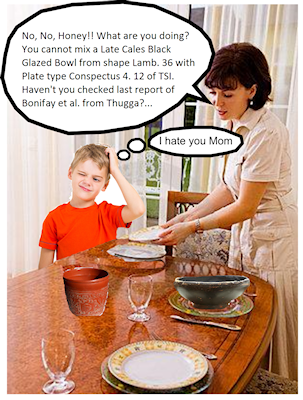
Cite this as: Bermejo Tirado, J. 2018 Domestic Patterns of Tableware Consumption in Roman Celtiberia, Internet Archaeology 50. https://doi.org/10.11141/ia.50.3
This article is divided into three interrelated parts. The first brief part discusses some methodological questions about the genesis and configuration of 'chrono-typologies' as the standard category of classification for the archaeological study of tableware finds in Roman contexts. I will analyse the theoretical and historiographical context in which 'chrono-typologies' were first proposed before discussing the suitability of using such classification categories as the basis for future studies characterising consumption patterns regarding Roman tableware.
The second part of the article, which will be more case-study orientated, will begin by describing an alternative approach to the study of domestic patterns of consumption of Roman tableware. This approach was in part inspired by some of the problems raised in the previous discussion. Finally, to illustrate this alternative approach, it will be applied to the analysis of three selected contexts from Roman domestic spaces documented in the area of Celtiberia. The final part of the article is devoted to explaining how the application of this alternative perspective, in comparison with other types of production-orientated classification, can be used to enhance our current knowledge about patterns of domestic consumption of Roman tableware. To approach this question, I will discuss the results of the application of various Correspondence Analyses performed on the data from each case study and how their application can be used to obtain a clearer visualisation of these patterns.
It is well known that, currently, the classification of Roman tableware finds, especially pottery production, by the use of 'chrono-typologies' is the most widespread procedure used by archaeologists to study this kind of material. These traditional 'chrono-typologies' could be defined as classification categories based on the shape of specific kinds of finds (mostly pottery production) in tandem with some production dates. Well-known examples of such 'chrono-typologies' are the amphora shape Dressel 1, the Hayes 10 shape of ARS (African Red Slip ware) plates, or the Drag. 37 and Ritt. 8 shapes of bowls of different types of TS (terra sigillata). Every year, hundreds of monographs, doctoral dissertations, journal articles, conference proceedings, research groups and archaeological associations enlarge the corpus of classified finds and the available number (and complexity) of typology categories for the analysis of further pottery finds. But, despite the huge quantity of valuable archaeological work, very few of the resulting publications offer any kind of deep reflection on the genesis and suitability of these standard 'chrono-typological' approaches as the methodological basis for the archaeological analysis of Roman tableware finds.
This trend is especially striking in those studies devoted to the characterisation of consumption patterns of various communities in antiquity. Of course, among the reasons for this are the conservative tendencies of much academic research and also a long-standing reluctance on the part of classical archaeologists (especially in Continental Europe) to engage in any kind of theoretical reflection. But in this article I want to focus attention on the conceptual framework that inspired the creation of 'chrono-typologies' in the early years of classical archaeology as an academic discipline. The creation of this kind of classification was influenced by the linear evolutionism in vogue in Europe during the second half of the nineteenth century, an era of archaeological study that Bruce Trigger has defined as the 'Antiquarianism period' (Trigger 2006, 80-121). Many publications (Daniel and Renfrew 1988, 13-37, 41-46; Schnapp 1997, 121-54; Schnapp and Kristiansen 1999, 24-28; Trigger 2006, 211-17) have highlighted the influence of geological or natural history models as the conceptual inspiration for the creation of the metaphor of material finds, especially pottery, as the 'fossil guide' for classical archaeology. The problem with the application of this model to classify archaeological finds is that, in many cases, archaeologists established linear sequences by introducing intermediate phases based only on the supposed, but in many cases not commonly attested, evolution of morphometric characteristics across time.
All these arguments lead to the conclusion that the development and application of morphological chrono-typologies for the analysis of tableware productions, even though very useful to provide some chronological ranges, introduce some distortions in relation to their original consumption context. I illustrate this methodological inconsistency through a cartoon of an imaginary mother and her son in the everyday situation of setting the table for a family lunch (Figure 1). The mother is correcting her child for not having sufficient knowledge of recent publications on tableware typologies. This absurd reference is intended to make us think about how different the cultural meaning of these pieces of tableware is in their historical context compared to their treatment in many current archaeological publications.

Archaeologists who developed methodological approaches for 'chrono-typological' classification of ancient finds in the last decades of the nineteenth century and the first half of the twentieth century were more interested in production and chronology than in consumption or use. But, if we agree that shape and function are two different dimensions of material culture, it does not seem very logical to use the same classification categories, coined by those pioneering archaeologists, to analyse consumption.
During research and writing up of my PhD thesis (Bermejo Tirado 2011) on 'Household Archaeology in Roman Celtiberia', I faced the problem of analysing domestic patterns of consumption through legacy data previously recorded using traditional 'chrono-typological' approaches. I therefore looked for alternative strategies for classification and quantification of these data. My initial approach was based on some of the procedures developed in the framework of so-called 'behavioral archaeology'. The works of authors such as Michael B. Schiffer (1972; 1987; 2010), James C. Skibo (1992; 2013; Schiffer and Skibo 1997) or Michael E. Smith (1987) and Smith and Heath-Smith (1994), among others, has been very beneficial for my own approaches. Other more recent applications focused on Roman contexts, such as the works of J.T. Peña (2007), have also been influential in the configuration of my classification and quantification procedures.
Based on these previous works, I want to summarise some analytical concepts that I consider fundamental for my own approach. The first one is 'technofunction', which, following James C. Skibo's definition (1992, 33-38), refers to technological aspects of an artefact's use. In the specific case of tableware finds, especially pottery, many scholars have developed extraordinarily precise tools for recording morphological variability and complex mathematical tools for the technofunctional classification of vessels. David Hally's article on the identification of vessel function in north-west Georgia (1986, fig. 3) can be also cited as a classic and influential example. The second concept that I want to introduce, namely usewear analysis, is an alternative analytical strategy orientated to the functional classification of archaeological artefacts from the point of view of the users. Usewear approaches are extraordinarily valuable in providing information related to the use of objects in terms of physical and embodied activity (Banducci 2014). The example of the imitation African cooking plate (Figure 2) documented in the House of the Plinths (Uxama Argaela, Soria, Spain) (García Merino et al. 2009, fig. 17, 5) in Roman Celtiberia can be used to illustrate that we should not establish functional correlations between classical typologies and functional categories of Roman wares. This piece was used in one of our case studies and could be classified as a local imitation of an African cooking ware plate (similar to Hayes Form 181/Bonifay Culinaire Type 5 C). Despite this relatively easy chrono-typological identification (Bonifay 2004, 215), the macroscopic recording of some usewear traces show us how this plate was used to cut food (probably bread) in similar-sized portions, thanks to the reference marks added along the rim. The cut food was then probably served on this same plate. Other plates of similar typologies may not have had the same function when used to prepare different dishes. Examples like this show us that a strict segregation between cooking wares and tablewares established by some classical typologies (with classification categories like Italian or African Cooking Wares) can be wrong in diverse cultural contexts, and should be tested case by case.
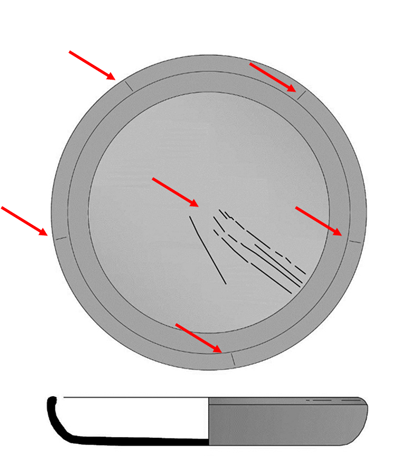
With these and other considerations in mind, for the analysis of domestic consumption patterns in Roman Celtiberia, I developed and applied an alternative typological concept that I have called 'functional grouping'. This analytical concept can be defined as a functional typology for archaeological finds in their given systemic context (Schiffer 1972) of consumption, designed to integrate methodological and theoretical elements of previous traditions of functional classification: 'technofunction', usewear analysis and cultural values.
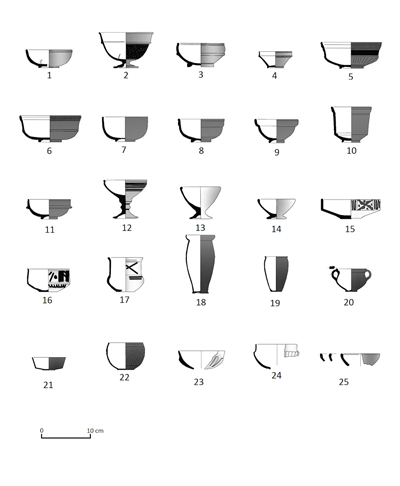
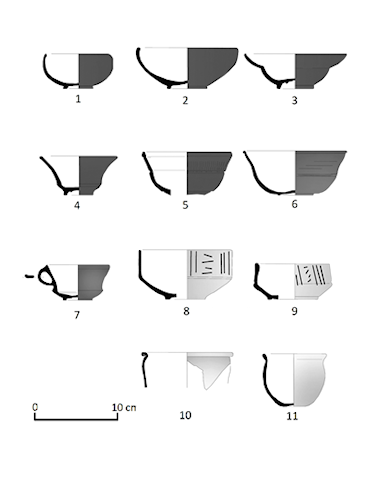
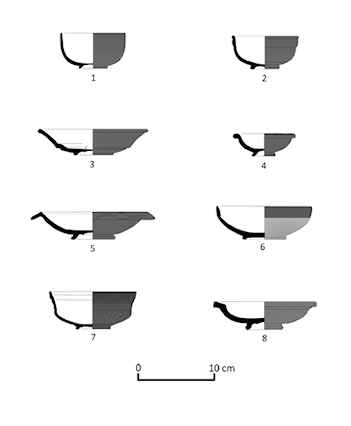
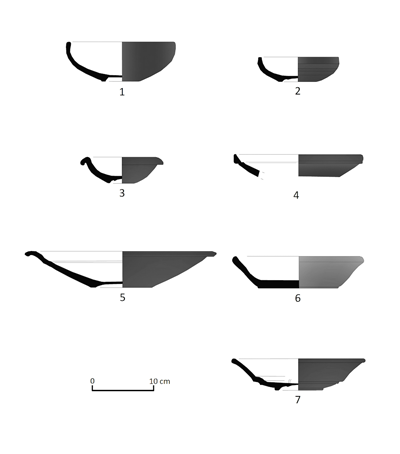
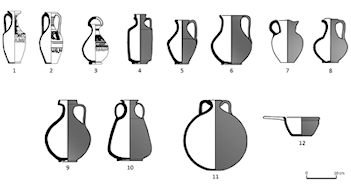
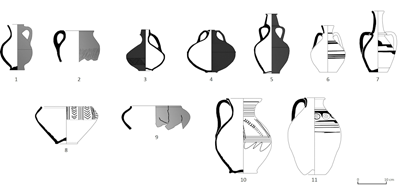

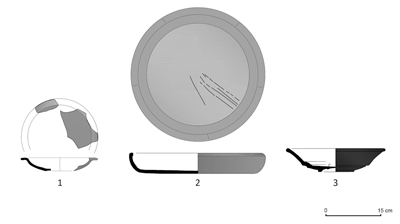
For the specific case of domestic tableware finds from Roman Celtiberia, I have established four main functional groupings (Bermejo Tirado 2014, 161-77): 1) Individual Consumption of liquids [Ind_Cons_liq] (Figures 3 and 4); 2) Individual Consumption of solids or semi-liquids [Ind_Cons] (Figures 5 and 6); 3) Communal Service of liquids [Com_Service_liq] (Figures 7 and 8); and 4) Communal Service of solids or semi-liquids [Com_Service] (Figures 9 and 10), using some morphometric ranges orientated to the measurement of rim shape and diameter, height, walls (angle, orientation and thickness) and surface treatments (Table 1). Basically, I assume that both functional categories of individual consumption comprised vessels used for the direct ingestion of liquids, solids or semi-liquids (such as some soups with solid components). Communal or convivial services were vessels designed for presenting food at the table or for serving different kinds of food and drink from other receptacles to vessels used for individual consumption.
| Ind_Cons | Ind_Cons_liq | Com_Service | Com_Service_liq | |
|---|---|---|---|---|
| Rim diameter (cm) | >13 | <12 | >18 | <15 |
| Mouth shape | Open | Closed | Open | Closed |
| Height (cm) | >15 | <10 | >15 | <20 |
| Wall angle | <90° | >70° | <90° | >70° |
| Wall orientation | + straight | + globular | + straight | + globular |
| Wall thickness (cm) | <0.3 | >1 | <0.5 | >1.2 |
| Surface treatment | varied | impermeable | varied | impermeable |
In methodological terms, my classification criteria are based on this archaeometrical approach. However, the exclusive use of morphometric characteristics for functional classification, as I have discussed above, always carries a certain amount of ambiguity. This is the case for some pieces, mostly cups and bowls with reduced dimensions that, following my archaeometrical criteria, should be classified under my Individual consumption of liquids or Individual Consumption of solids or semi-liquids 'functional groupings'.
However, using the interpretation of some ancient literary sources (Dannell 2006, 158-61), these small cups or bowls could also relate to the communal serving of sauces. These kinds of discussion show us that, in practice, no functional classification can be definitively established following morphometrical criteria exclusively (Dannell 2006, 162-63). Thus, my proposal for reducing the inaccuracy of the 'functional groupings' used as classification categories of Roman tableware is based on two procedures. The first avoids the de-contextualising use of traditional 'chrono-typologies' as the main basis of our classifications criteria, and the second uses the systematic introduction of usewear analysis to counter previous literary or morphometric assumptions, as shown in the discussion of usewear traces on the local imitation of African Cooking Ware plate shape Hayes 181.
The analysis of contexts that range from the first century CE to the early fifth century CE allowed me to propose ideal tableware sets for each functional group in Roman Celtiberia (Bermejo Tirado 2014, 161-73) both for the Early and Late Roman periods (Figures 3–10).
An important element of my alternative approach to the classification of Roman tableware finds is that, contrary to the traditional chrono-typologies, my functional groupings are not exclusive categories. The documentation of usewear traces related to different uses can be used to classify the same item into two (or even more) different functional groups. This is an important aspect of consumption analysis in ancient communities where, in contrast to modern industrial societies, the use of material culture cannot be conflated with our current 'use and throw away' functional hyper-specialisation (Deetz 1977, 120-37; Rathje and Murphy 2001; González-Ruibal 2003, 52-56).
The second part of this article will be devoted to illustrating the possibilities of the application of this 'alternative' approach to analyse domestic patterns of consumption of tableware in Roman Celtiberia, based on the diachronic investigation of some case studies from the Early and Late Roman period.
The territory of Roman Celtiberia (Figure 11), in the province of Hispania Tarraconensis, is an area that coincides with the modern region of the Serranía celtibérica, a region of the north-eastern part of the Central Meseta that is homogeneous in terms of its terrain, climate and demography (Curchin 2004, 1-23). This region was definitively conquered by the Romans in the Celtiberian Wars that ended with the siege of Numantia by the troops of Scipio Aemilianus in 133 BCE (Polybius, Histories III, XXXV, 1-2; Appian, Iberica 76-80; Salinas de Frías 1986; Burillo 2007, 251-426).

I have sampled three different assemblages within specific sites documented in this area to exemplify how the classification of tableware, in comparison to other archaeological data, can be used to characterise in a relatively precise way the domestic patterns of consumption of this kind of material in a Roman region.

The first case study is the Domus of the Aqueduct, in Tiermes (Soria) (Figure 12), a former Late Iron Age hillfort, that evolved into one of the most important Roman cities in the area. This Roman domus, named from its position near the course of one of the city's aqueducts carved in the rock, was completely excavated under the direction of J.L. Argente between 1979 and 1986 (Argente 1991; Argente et al. 1994). This excavation uncovered the layout of a local domus in which we can appreciate the impact of the Roman house model in Italy, such as the construction of a central atrium with impluvium or the use of a 'fake wall' technique to protect the wall paintings of the so-called oecus or triclinium of the house from the humidity produced by the aqueduct (Argente et al. 1994, 60-65). In the eastern part of the building, next to the main entrance, excavated from 1983 to 1985, archaeologists discovered some abandonment deposits that could be related to a chronological range that runs from the middle of the first century CE to the first decades of the second century (Bermejo Tirado 2014, 249-80). Even when the stratigraphic depth of this area was shallow (and the archaeological standards of documentation were not similar to those now current), the special conditions of construction of the house, in which many rooms were carved in the bedrock, allowed the abandonment levels to be identified with relative accuracy (Bermejo Tirado 2014, 254-57, annex I). The recording of an interesting number of everyday finds (such as a high number of gaming tokens and some extraordinary silver finds, especially some clothing buttons with reliefs) seems to confirm this aspect. Here the sample analysed comprises 545 items classified in terms of functional groupings, 147 of which belong to tableware categories (Data File, Domus of the Aqueduct).
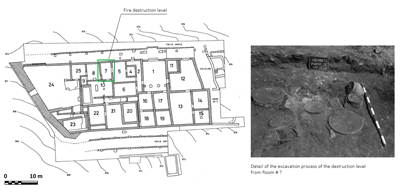
The second case study is the so-called Domus of the Plinths (Figure 13) (named after the recording of two stone column plinths in the main entrance of the house) located in Uxama Argaela (Soria) (García Merino 1991; Gillani et al. 1994), another former Celtiberian hillfort converted into a Roman municipium probably during the Flavian period (García Merino 1997). The excavations, undertaken in the late 1990s under the direction of Carmen García Merino and Margarita Sánchez Simón, documented the entire area of a structure that was built in the first century CE, later remodelled, and then destroyed by a fire in the second half of the third century CE. In room number 7, archaeologists discovered an entire destruction level with an unaltered deposit dating from the fire event (García Merino et al. 2009). It consists of 101 artefacts, generally quite well preserved, with associations among ware productions, metal objects, coins and some furniture pieces. Of these pieces, 32 have been classified in at least one of the four functional groupings of tableware (Data File, Domus of the Plinths).

The last case study sampled belongs to the so-called Roman villa of 'La Dehesa' from Cuevas de Soria (Quintana Redonda, Soria) (Figure 14), located in an area near the Duero Valley. The site was first discovered and excavated in the 1920s by Blas Taracena, the former director of the Numantine Archaeological Museum of Soria (Taracena 1930). Later excavations, under the direction of Maria Mariné, in the second half of the 1980s, uncovered a hydraulic complex at the south-east part of the site, linked to a domestic balneum, the function of which is still unclear (Mariné 1985). Excavation of the deposits that filled this installation revealed several levels of landfill, which were deposited at a similar rate and elevation in each of the six holes of this structure. These landfill levels can be interpreted as abandonment deposits with traces of the everyday refuse from the Late Roman phase of the villa (Bermejo Tirado 2014, 289-95), that covered the second part of the third century CE and the whole of the next century, and ended in the first decades of the fifth century CE. Within these levels we have recorded 127 items with a functional grouping, 43 of which can be identified as tableware pieces (Data File, Roman villa of La Dehesa).
To compare this alternative perspective to other series of data associated with traditional categories of tableware classification, I have carried out Correspondence Analysis (CA) using the relevant data from the three sites above, using a relatively simple form of this multivariate statistical technique to summarise 'hidden' correspondence or consistency patterns between a multiple number of categories of two or more types and with multiple values (see e.g. Cool and Baxter 1999; Pitts 2007; 2010; see also Sterry, this volume). I have used the software IBM SPSS (Statistical Package for Social Sciences) Version 17.0 to carry out the analysis and to generate the two-dimensional graphs of distribution.
I have sampled two dimensions of these data (see Data File): the first comprises a range of the four functional groupings (func_groupings equivalences), while the second dimension is composed of a range of the different fabric types documented in each site (fabric_equivalences). All these variables are weighted by the Minimum Number of Individuals (MNI) ascribed to each of the functional groupings. An important aspect is that all Correspondence Analyses performed show significant results under 0.05, which is considered the statistical standard for the correspondences to be relevant.
| Abbreviation | Description | Source/Reference |
|---|---|---|
| ACW | African Coarse Ware | Hayes 1972 |
| ARS | African Red Slip Ware | Hayes 1972 |
| CPTL | Local Roman Painted Pottery | Abascal 2008 |
| LCW | Local Coarse Ware | Bermejo Tirado 2014 |
| Thin W | Thin-walled pottery | Mayet 1975 |
| TSH | Terra Sigillata Hispana | Mezquíriz 1961 |
| TSI | Terra Sigillata Itálica | Conspectus |
| TSHA | Terra Sigillata Hispana Avanzada | Paz Peralta 2008 |
| TSHB | Terra Sigillata Hispana Brillante | Fernández-Ochoa and Zarzalejos 2008 |
| TSHGris | Terra Sigillata Hispana Gris | Rigoir 1971 |
| TSHT | Terra Sigillata Hispana Tardía | Paz Peralta 2008 |
| TSSG | Terra Sigillata Sudgálica | Passelac and Vernhet 1993 |
Starting with the results shown on the distribution graph of the Domus of the Aqueduct (Data File, Domus of the Aqueduct), the oldest, we can distinguish some clear correspondence patterns (Figure 15). For example, the relationship between thin-walled vessels and the individual consumption of liquids, as shown in this graph, has been previously highlighted by many authors (i.e. Mayet 1975, 214; Desbat 1986, 80). More consistent (but maybe less obvious) is the correspondence of coarse ware vessels with the communal or convivial service of liquids. The preferred use of these locally produced items for serving liquids, an activity with clear social implications, reveals an interesting pattern of tableware consumption. Also interesting is the concentration of all TSH, TSHB (Table 2), and their local imitations, in the functional groups devoted to the consumption of solids or semi-liquids.
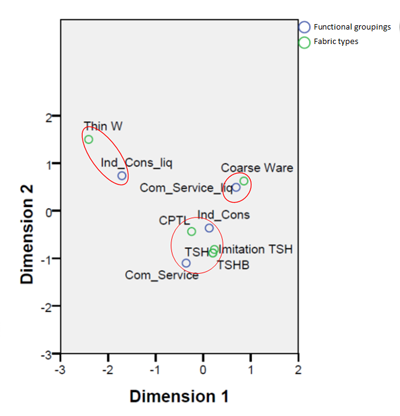
The second case (Figure 16), in terms of its antiquity, was the fire deposit from the third century CE excavated in the Domus of the Plinths (Uxama) (Data File, Domus of the Plinths). Here I found certain continuity in the consumption patterns documented in the Domus of the Aqueduct, but with some subtle peculiarities. The first is the use of glass vessels, in the main, instead of thin-walled pottery for the individual consumption of liquids. In addition, we can perceive a similar pattern of correspondence of TSH and its local imitations with the functional groupings devoted to the consumption of solids. Also consistent with the patterns documented in the Domus of the Aqueduct is the correspondence of coarse-ware products for communal or convivial service of liquids, but in this case we can attest also the, less consistent but interesting, association of pieces of TSHB with the same functional grouping, which introduce a change in the patterns documented between both domūs (Figure 16, marked in blue).
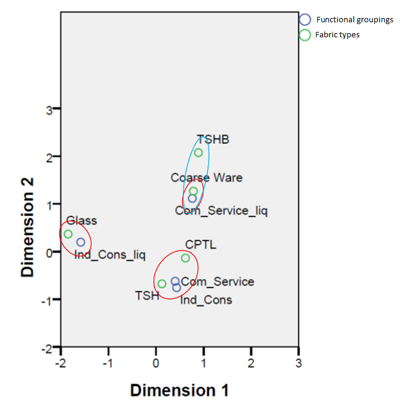
The last example analysed (Figure 17), the landfill deposits from the Late Roman villa of 'La Dehesa' in Cuevas de Soria (Data File, Roman villa of Le Dehesa), shows some changes. The first is that the individual consumption of liquids is no longer associated with glass production but with relative humble pieces of local coarse ware. A few pieces of glass have been documented, but these relate to platters for communal or convivial use (Figure 17, marked in blue). Interestingly, the convivial service of liquids is mainly associated with pieces of local Roman painted pottery, which is consistent with the preferred use of local ceramics for this functional group of tableware in all cases analysed (Figure 17, marked in blue). Also consistent with the other cases is the concentration of correspondences of terra sigillata wares with the functional grouping related to the consumption of solids.

Of course, it must be noted that in order to reach more definitive conclusions I will need to establish comparisons with a larger number of cases. But, even in this preliminary stage of the research, some inferences about regional patterns of domestic consumption of Roman tableware can be drawn.
All these domestic contexts show a clear pattern of specialisation in the consumption of some types of products for a specific purpose, even when in the formal repertoires of some of these products (especially TSH, TSHB and TSHT, see Table 2) conventional typological studies have identified shapes that could be ascribed, at least in technofunctional terms, to all of the four tableware functional groupings employed in my studies of household archaeology in this region (also see Pitts 2007; 2010; to see the potential of CA analysis to highlight the differences of local patterns consumption). This means that, rather than be considered as passive, conspicuous, or 'consumerist' (Miller 1987; Greene 2008; Wallace-Hadrill 2008, 315-440) consumers of Roman tableware in provincial households managed their own selection criteria of consumption, probably explained by specific local or regional traditions. A good example of such local trends has been documented in the preferred use of local forms of local painted pottery or coarse wares for serving liquids. The fact that inhabitants of Roman Celtiberia used these local vessels for these convivial functions is striking in comparison with other neighbouring areas of Hispania such as the Roman Carpetania or the Ebro valley, where the consumption of TSH, TSHT or even ARS (Table 2) for the service of liquids is extensively documented (Paz Peralta 1991; Bermejo Tirado 2017).
In terms of supply and trade, the domestic spaces of the Roman Celtiberia were under minimal influence from interprovincial networks. The majority of tableware products consumed in these houses had a local or perhaps regional origin. In part, this can be linked to the relatively isolated position of the region in the interior of Central Spain, but also must be related to the persistence of local needs of consumption that interacted from similar positions with the importation of Roman trends.
Finally, I want to note that despite attesting the persistence of common long-term patterns, this kind of comparative analysis also allows us to reveal some individual peculiarities in the consumption patterns of specific domestic places. We archaeologists are normally interested in parallels and systematisation, but I think that, especially for the development of alternative historiographical narratives, the record of differences should also be a matter of interest for scholars. The development and application of this kind of alternative approach, in comparison with the data provided by more conventional studies, will allow us to make detailed inferences for the characterisation of Roman domestic patterns of consumption at a domestic, local and regional scale. I hope also to have shown the importance of theoretical reflection on our current categories of analysis together with our intended methodological and historiographical interests.
Internet Archaeology is an open access journal based in the Department of Archaeology, University of York. Except where otherwise noted, content from this work may be used under the terms of the Creative Commons Attribution 3.0 (CC BY) Unported licence, which permits unrestricted use, distribution, and reproduction in any medium, provided that attribution to the author(s), the title of the work, the Internet Archaeology journal and the relevant URL/DOI are given.
Terms and Conditions | Legal Statements | Privacy Policy | Cookies Policy | Citing Internet Archaeology
Internet Archaeology content is preserved for the long term with the Archaeology Data Service. Help sustain and support open access publication by donating to our Open Access Archaeology Fund.